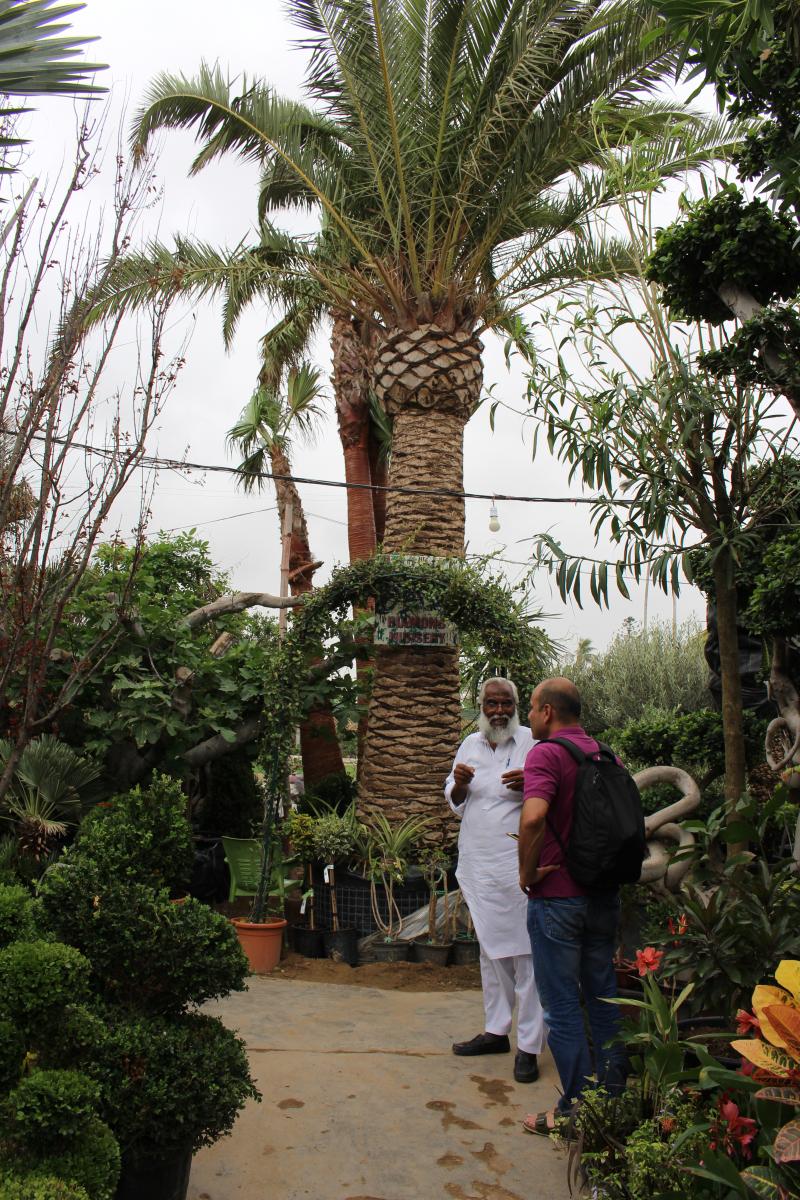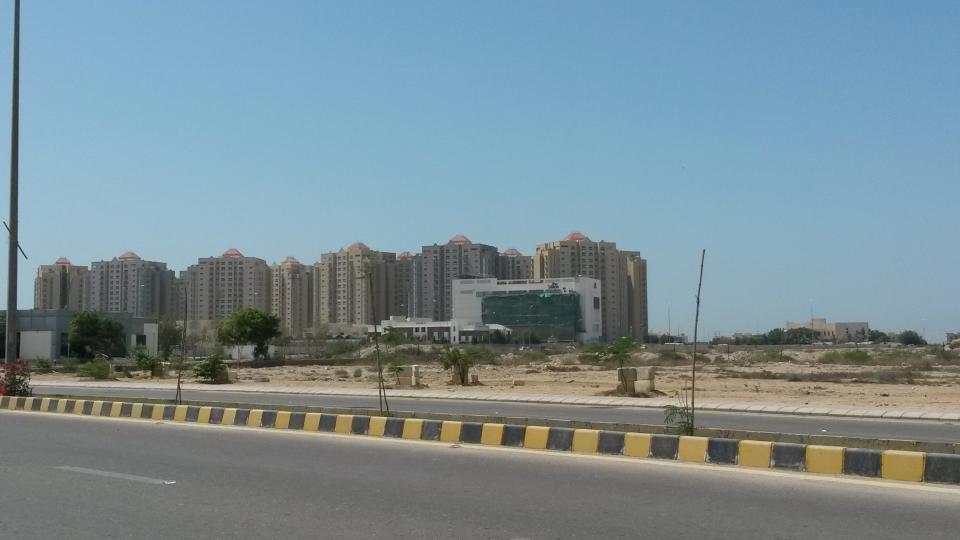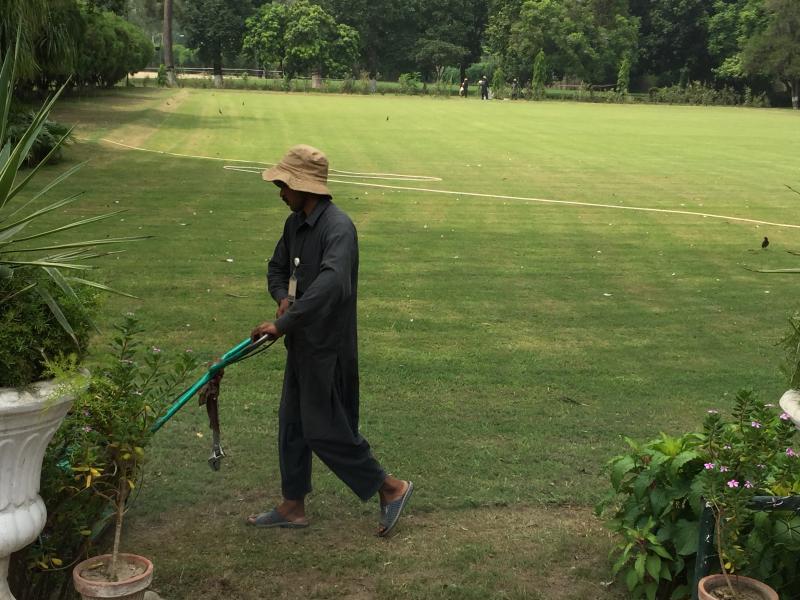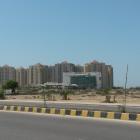In 2015, South Asia experienced one of its most severe heat waves in living memory, with 3,500 recorded deaths across the subcontinent. Rural agricultural workers and low-income urban residents suffered most. In Karachi, Pakistan’s largest city with a population of 20 million, 1,300 people died. The city was ill-prepared to deal with the scale of the crisis. “Bodies stacked up outside graveyards and morgues,” as one official put it.

An experienced nurseryman explains the changing economy of urban horticulture
An experienced nurseryman explains the changing economy of urban horticulture
Photograph by Franklin Ginn.
 This work is licensed under a Creative Commons Attribution 4.0 International License.
This work is licensed under a Creative Commons Attribution 4.0 International License.
Having orchestrated and surfed waves of ethno-political violence throughout the 1990s and 2000s, the Muttahida Qaumi Movement (MQM) consolidated power over the city government with the election of Mustafa Kamal as mayor in 2005. MQM quickly rebranded itself as a modern, secular, neoliberal party to appeal to middle-class voters. Their Karachi 2020 Strategic Plan (2007) boasted of turning the megacity into a “world class destination for business and finance.” Among its many initiatives, the plan earmarked 10 billion rupees for increasing the number of green areas in the city. Motivations included aesthetics, alleviating air pollution, and—anticipating future heatwaves—cooling and shade.
Horticultural planners advised that a range of exotic and native trees, such as neem, gulmohar, and cypress, would be most suitable. But instead of a mixed ecology, in 2009 the government began a monocultural mass planting of Conocarpus erectus, a coastal wetland tree native to the Americas. Conocarpus is salt-, heat-, and sun-tolerant, making it suited to Karachi’s climate. It is also fast-growing—up to a foot a year—and cheap to cultivate on a large scale, at three rupees a cutting. But instead of alleviating the 2015 heatwave, the city’s several million conocarpus made the crisis worse. Agricultural researchers had long argued that the tree’s pollen was a public health threat, since it exacerbates asthma and causes respiratory problems—they were proved correct. In a move typifying the “ordered disorder” characteristic of Karachi, conocarpus was banned in 2016 in favour of a wider mix of species. Mass conocarpus planting might have been part of MQM’s political strategy, but it turned out to be an ineffective gloss over deep-seated urban inequality and vulnerability.

Struggling conocarpus in the coastal development zone of Defence, an elite residential area.
Struggling conocarpus in the coastal development zone of Defence, an elite residential area.
Photograph by Franklin Ginn.
 This work is licensed under a Creative Commons Attribution 4.0 International License.
This work is licensed under a Creative Commons Attribution 4.0 International License.
Plants play a visible role in the political formations of Karachi, not just at the city-wide level, but also on the level of the landscape. Over the last few decades, wealthy Karachiites have concentrated in the military cantonments of Defence and Clifton. Owned and administered by the Pakistani military, these securitized spaces offer relative stability and comfort to those who can afford it. As one property billboard puts it: “Buy here and live like abroad!” Clifton Cantonment Board’s lead horticulturalist regularly travels to the United Arab Emirates and imports their “modern landscape design,” including frequent planting (in neat, military-style rows) of the iconic date palm—a tree singularly unsuited to Karachi’s arid climate. The Defence Horticultural Association, meanwhile, has been planting hundreds of coconut palms each year for several decades. These trees may evoke tropical climes, but quickly succumb to the salt and heat of coastal Karachi. Karachi’s uneven geography of class power is signalled by the unsustainable Dubai aesthetic: exotic plants and green lawns supported by high inputs of labor, chemicals, and water.

Maintained through high inputs of water, chemicals, and cheap labor by maali (gardeners), the lawn aesthetic exerts a powerful cultural pull
Maintained through high inputs of water, chemicals, and cheap labor by maali (gardeners), the lawn aesthetic exerts a powerful cultural pull
Photograph by Franklin Ginn.
 This work is licensed under a Creative Commons Attribution 4.0 International License.
This work is licensed under a Creative Commons Attribution 4.0 International License.
The private gardens of the elite present a theatrical backdrop for the game of making and maintaining social privilege. Part of this game is projecting oneself as part of a cosmopolitan, outward-looking Pakistani elite, a trend boosted by General Musharraf’s middle-class-friendly economic policies (1999–2007). Status is often marked by exotic species. As one nursery owner put it: “It used to be if you were rich you’d show off by drinking, buying whores, cars—now they’ve realized they might as well get some plants too.” When receiving guests and entertaining, a green turfgrass lawn is a key status signifier. In a highly water-stressed city, with threadbare municipal supply and sanitation, lawns soak up vast quantities of water. Drive around the elite residential sectors on any given day and you will see large water tanker trucks plying their trade, stark reminders of the unjust water politics of Pakistan. Pushed by rising water prices, however, growing numbers of the liberal elite are uprooting their lawns and turning to less water-hungry plants, a sign that the lawn aesthetic is not all-powerful.
Better-quality green spaces beyond elite enclaves would alleviate everyday conditions for the city’s poor. This would not be a structural change towards urban justice, but a change that might make getting through the dust and dirt of the day a little more tolerable. But for the most part, plants seem locked into games of status and patronage-based politics at the city, landscape, and household levels. The poor lack space to garden, and the climate means that few ruderal plants flourish. As gardening activist Tofiq Pasha puts it, “Every tree here has been planted by someone and is being watered by someone. They have been watered—or they die.” With water being an expensive commodity, Karachi’s plants prosper only insofar as they are supported by elite power.
How to cite
Ginn, Franklin. “Plant Politics in Karachi.” Environment & Society Portal, Arcadia (Spring 2018), no. 12. Rachel Carson Center for Environment and Society. doi.org/10.5282/rcc/8318.
ISSN 2199-3408
Environment & Society Portal, Arcadia
 This work is licensed under a Creative Commons Attribution 4.0 International License.
This work is licensed under a Creative Commons Attribution 4.0 International License.
2018 Franklin Ginn
This refers only to the text and does not include any image rights.
Please click on an image to view its individual rights status.
- Breman, Jan. “The Undercities of Karachi.” New Left Review 76, (2012): 49–63.
- Ginn, Franklin. Domestic Wild: Memory, Nature and Gardening in Suburbia. London: Routledge, 2016.
- Ginn, Franklin, and Eduardo Ascensão. “Autonomy, Erasure and Persistence in the Urban Gardening Commons.” Antipode (forthcoming, 2018).
- Head, Lesley, Jennifer Atchison, Catherine Phillips, and Kathleen Buckingham. Vegetal Politics: Belonging, Practices and Places. London: Routledge, 2015.
- Mustafa, Daanish, Tom Smucker, Franklin Ginn, Rachel Johns, and Sarah Connelly. “Xeriscape People and the Cultural Politics of Turf-Grass Transformation.” Environment and Planning D: Society & Space 28, no. 4 (2010): 600–17.
- Mustafa, Daanish. Water Resources Management in a Vulnerable World: Hydro-Hazardscapes of Climate Change. London: I .B. Tauris, 2012.
- Robbins, Paul. Lawn People: How Grasses, Weeds, and Chemicals Make Us Who We Are. Philadelphia: Temple, 2007.








